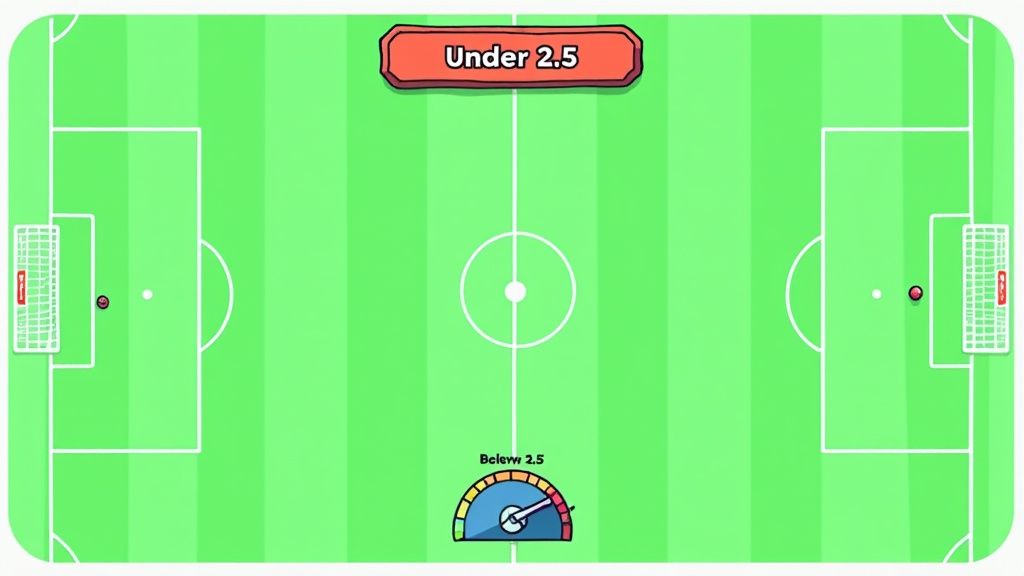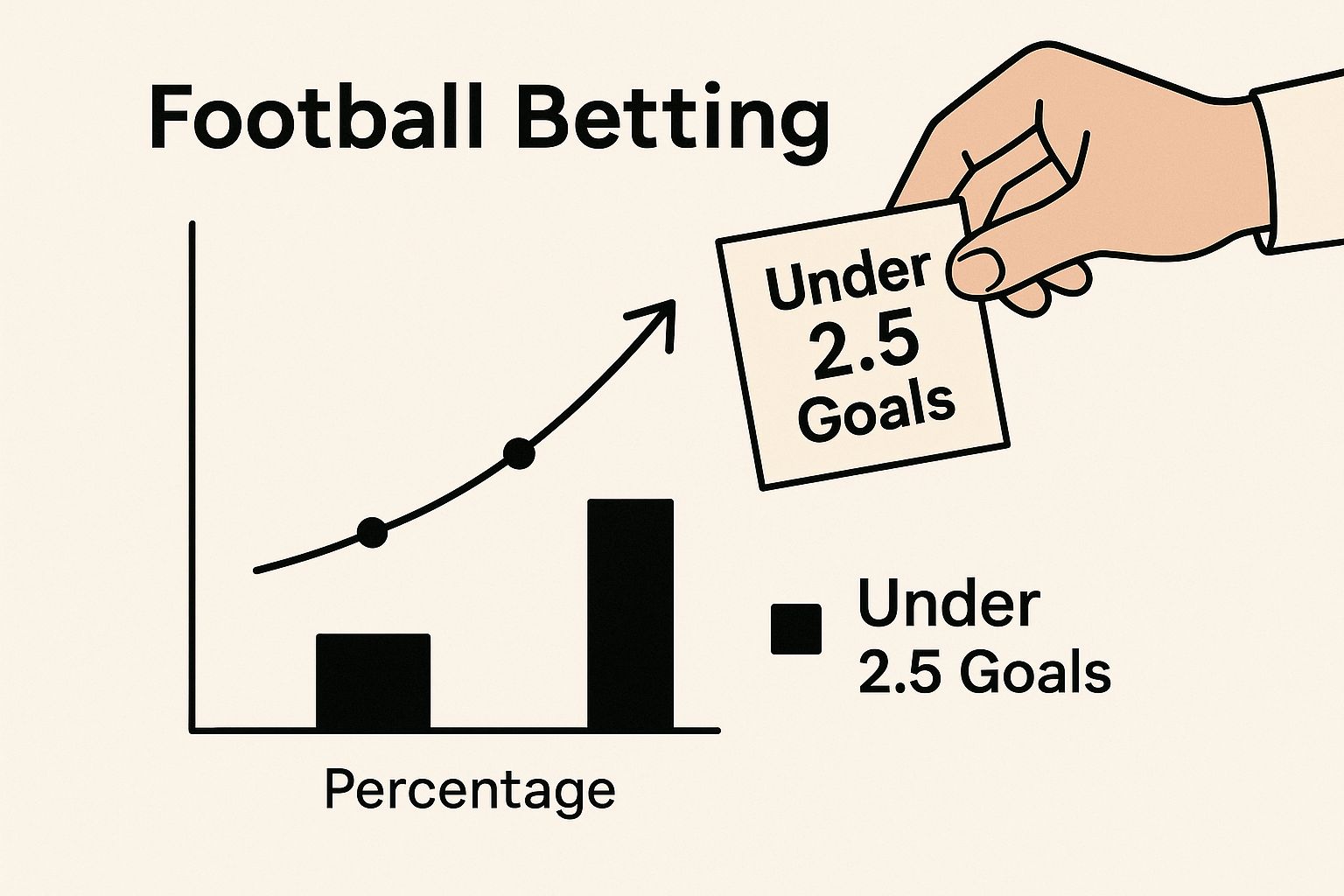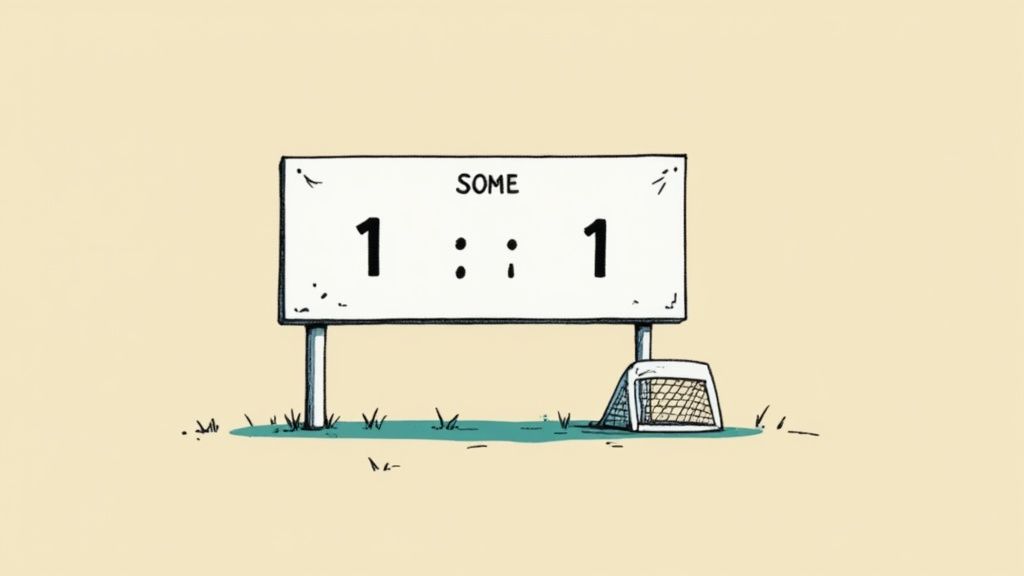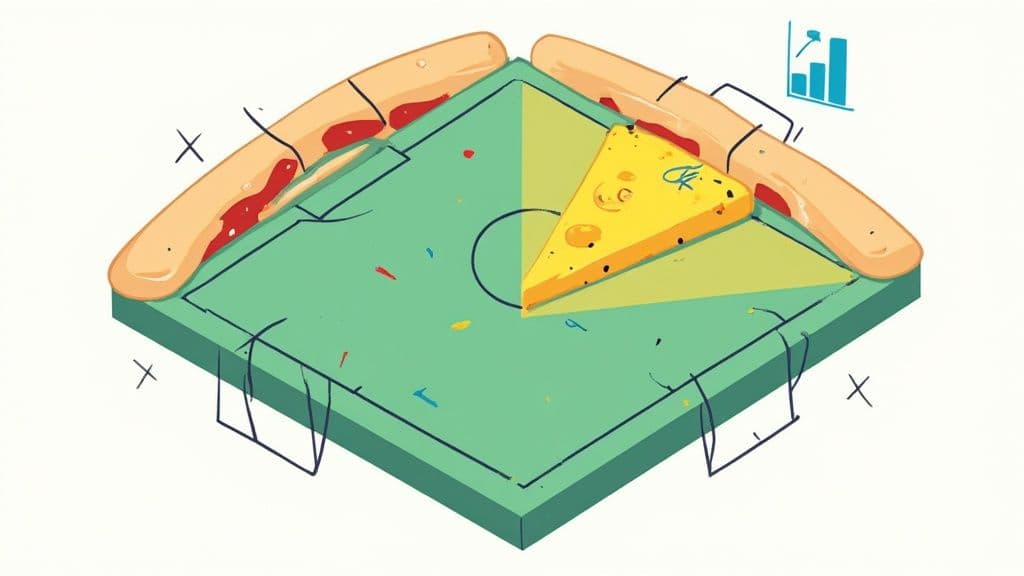Cracking the Code: What Under 2.5 Goals Really Means
The phrase under 2.5 goals might look strange at first. How can half a goal be scored in a football match? This is simply a clever way for bookmakers to create a bet with only two possible outcomes: you either win or you lose. It removes any grey areas like a 'push' bet, where your stake is just returned.
Think of it as a clear dividing line. If the total goals scored by both teams is two or less, the bet is a winner. If the combined total is three or more, the bet is a loser. It's a straightforward concept that simplifies goal-based betting.

597d2fff-f4e3-48df-ac4c-308cae51309d.jpg
Winning vs. Losing Scenarios
To really get to grips with this market, let's break it down with some practical examples. An under 2.5 goals bet wins if the final score is one of the following:
- 0-0 (0 total goals)
- 1-0 or 0-1 (1 total goal)
- 1-1, 2-0, or 0-2 (2 total goals)
On the flip side, your bet would lose with scorelines like 2-1, 3-0, or 2-2, because the total goals are three or higher. This market is especially popular in the UK, often pointing towards a low-scoring, tactical match. In the English Premier League, for example, the percentage of games finishing with fewer than three goals often sits around the 45%-50% mark, which shows how frequently these outcomes occur. You can dive deeper into these trends by exploring detailed soccer stats.
The main appeal of this bet is its simplicity. You don't need to worry about which team wins, who scores, or when the goals are scored. Your attention is fixed on a single question: will the match see fewer than three goals in total? This makes it a great option for punters who are good at spotting potentially tight, defensive games.
Real Matches That Tell the Under 2.5 Goals Story
Theory is one thing, but seeing how the under 2.5 goals meaning plays out in a real match is where it all truly clicks. Premier League history is filled with perfect examples that demonstrate the nature of this market. These aren't just dull 0-0 draws; they are often intense, tactical battles where every pass and tackle carries immense weight.
Let's break down how this works using examples that any football fan can recognise.
The Tactical Masterclass: A Classic 1-0 Victory
Imagine a classic José Mourinho-style performance: a team scores an early goal and then organises a formidable defensive wall for the rest of the match. The final score is 1-0.
- Total Goals: 1
- Bet Result: Winner. The single goal is comfortably below the 2.5 threshold.
- Why it Worked: These matches are defined by defensive solidity. Teams prioritise protecting their lead over chasing more goals, making them ideal candidates for an under 2.5 goals bet. The excitement comes from the tension of the defence holding firm, not from an onslaught of goals.
The Nail-Biter: A Heart-Stopping 2-1 Game
Now, let's look at a more dramatic scenario: a back-and-forth game that ends 2-1. Many punters assume this scoreline means their under 2.5 goals bet has lost, but that’s a common and costly mistake.
- Total Goals: 3
- Bet Result: Loser. The combined total of three goals is higher than 2.5.
This example is crucial. It shows that even thrilling matches can hover right around this line. The decisive factor is the final tally. A 1-1 or 2-0 result would have made the bet a winner. Understanding these fine margins is what separates a novice from a more experienced bettor.
The Numbers Game: Under 2.5 Goals Across English Football
Knowing the under 2.5 goals meaning is the first step, but the real art lies in knowing where to apply this knowledge. Not all football leagues play the same way. The tactical approaches, defensive priorities, and overall quality of play can differ hugely between divisions, which creates clear statistical patterns. If you can spot these differences, you can find a significant edge.
From the Premier League to League Two
While the Premier League often grabs the spotlight with its high-scoring thrillers, other English leagues can offer more consistent opportunities for under 2.5 goals bets. A closer look at the data shows that England's second tier, the Championship, is often a home for tighter, more defensively disciplined matches. In fact, data shows that games in the Championship finish with two or fewer goals around 52%-55% of the time, making it a prime location for this market. You can delve into more league-specific statistics by exploring the detailed breakdowns on sites like Progressive Betting.
The infographic below shows how successfully picking under 2.5 goals bets can lead to a positive trend in your overall results.

17f14ca8-7759-4636-9e6f-fe4c5802786a.jpg
This visualises a simple but powerful idea: finding regular value in low-scoring games is a key part of a sustainable betting approach. Leagues such as the Championship, or even League One, frequently provide these chances because the promotion and relegation stakes are immense, forcing teams to prioritise defensive solidity.
To give you a clearer picture, let's compare the frequency of under 2.5 goals outcomes across the top tiers of English football.
| League | Under 2.5 Goals % | Average Goals Per Game | Typical Range |
|---|---|---|---|
| Premier League | 45% - 48% | 2.70 - 2.85 | Often > 2.5 |
| Championship | 52% - 55% | 2.45 - 2.60 | Balanced |
| League One | 50% - 53% | 2.50 - 2.65 | Slightly > 2.5 |
| League Two | 48% - 51% | 2.60 - 2.75 | Often > 2.5 |
As the table shows, the Championship consistently has the highest percentage of games finishing with under 2.5 goals. This makes it a statistically sound starting point for anyone looking to focus on this betting market.
Why League Identity Matters
Of course, looking at entire leagues only gets you so far. To really sharpen your selections, you need to dig into the data for specific teams and players. A fantastic tool for this is Expected Goals (xG), a metric that measures the quality of chances a team creates. By learning what Expected Goals means, you can better predict a team's attacking potential. When you compare a team's xG with their defensive record, you start to paint a very clear picture of whether their upcoming match is likely to be a cagey, low-scoring affair or an open, end-to-end battle.
How Modern Football Created the Perfect Under 2.5 Goals Era
The beautiful game has certainly changed over the years. Gone are the days of consistently chaotic, high-scoring matches. Today's football is a far more disciplined and strategic affair, shaped by the tactical minds of managers like José Mourinho and Diego Simeone. This evolution has made understanding the under 2.5 goals meaning a particularly useful skill for any football fan.
The Rise of Defensive Solidity
Modern coaching places a huge emphasis on defensive organisation. Instead of simply attacking with abandon, top teams now operate in highly structured defensive shapes and use coordinated pressing systems to shut down their opponents. This isn't just "parking the bus"; it's a calculated game of control, patience, and limiting the other team's clear-cut chances.
As a result, many elite-level games have become tense, tactical chess matches where a single goal often decides the outcome. This shift towards more reserved scorelines has created the ideal environment for under 2.5 goals betting to thrive.
The data backs this up. If you look back to the early 2000s, an average Premier League match saw around 2.7 goals per game, putting it just over the 2.5 mark. This meant fewer games finished with two goals or less compared to today. You can explore more historical goal data on Statschecker to see this trend for yourself. The story is clear: today's tactical discipline has fundamentally changed the nature of football scores.
What This Means for Bettors
For anyone looking to place a bet, this tactical era presents a clear opportunity. By analysing a team's defensive record, how they press, and their manager's overall philosophy, you can make well-informed predictions. A side known for keeping clean sheets and grinding out 1-0 victories becomes an obvious candidate for an under 2.5 goals bet.
The modern game's focus on control and minimising risk has, in effect, made the under 2.5 goals market one of the most logical and predictable betting landscapes available.
Winning Strategies That Actually Work for Under 2.5 Goals
Knowing the under 2.5 goals meaning is one thing, but using that knowledge to win bets requires a smart approach. Successful betting isn't about blind luck; it’s about spotting the patterns and factors that consistently produce low-scoring football matches. By digging into key data before you place a wager, you can shift from hopeful punting to making informed decisions.

cc707d9e-4bae-4b80-9b2d-116d0015b274.jpg
Analyse Defensive Form and Team Styles
The most dependable strategy begins with team analysis. Your first step should be to identify teams built on a rock-solid defence rather than a free-flowing attack. These are often the sides that specialise in grinding out tight 1-0 wins or securing disciplined 0-0 draws, particularly when playing away from home. Their recent results, clean sheet records, and goals conceded statistics are the most valuable pieces of information you can find.
On the other hand, a match between two high-scoring teams with leaky defences is an obvious red flag for an under 2.5 goals bet. A team’s style of play is also critical. A side that values possession and slow, methodical build-up play is far more likely to be involved in a cagey, low-scoring game than one that thrives on fast, chaotic counter-attacks.
Consider Situational and External Factors
Context is everything in football betting. The importance of a match can completely change how it plays out. For instance, a tense relegation six-pointer or the first leg of a cup tie often leads to a cautious, risk-averse approach from both managers. This creates an ideal scenario for an under 2.5 goals bet.
It’s also crucial not to ignore the conditions on the day. Several external factors can put a damper on attacking football:
- Poor weather: Heavy rain or strong winds can turn a match into a slog, making slick, goal-scoring play almost impossible.
- Pitch quality: A bobbly, poorly maintained pitch disrupts passing rhythm and often leads to fewer clear-cut chances being created.
- Key player absences: If a team's star striker is injured or their main creative midfielder is suspended, their ability to score goals is significantly weakened.
To help you put all this information together, we've created a table outlining the most important factors to consider.
| Factor | Importance Level | What to Look For | Red Flags |
|---|---|---|---|
| Defensive Form | High | Teams with recent clean sheets and a low "goals against" average. | A team that has conceded 2+ goals in several recent matches. |
| Team Style | High | Cautious, possession-based teams or defensive counter-attacking sides. | Two teams known for high-pressing, end-to-end football. |
| Match Importance | Medium | Cup-tie first legs, relegation battles, or derby matches known to be tight. | End-of-season "dead rubber" matches where teams play with freedom. |
| Key Absences | Medium | A team's top goalscorer or key playmaker is injured or suspended. | Defensive players are missing, forcing a reshuffle at the back. |
| Weather/Pitch | Low-Medium | Heavy rain, strong winds, or a visibly poor playing surface. | Perfect playing conditions that favour fast, attacking football. |
This table acts as a quick checklist. The more factors that point towards a low-scoring game, the stronger your potential bet becomes. While no single element guarantees a result, a combination of these indicators can greatly improve your chances of success.
Finally, to get the best value, it's wise to shop around for odds. Using a reliable football odds comparison tool can help you find the most favourable prices for your chosen bets, which boosts your potential returns over the long term.
Avoiding the Pitfalls That Drain Your Betting Bankroll
Even with a solid grasp of what under 2.5 goals means, several common traps can quickly empty your betting bankroll. Success in this market isn't just about picking teams with great defensive records; it requires a disciplined approach and an eye for context, something even seasoned bettors can sometimes forget.
Misreading the Match Context
One of the most expensive mistakes is failing to see the unique circumstances of a specific fixture. A match isn't just a collection of statistics; it's a story waiting to unfold, and the plot can change dramatically.
- Cup Ties: First-leg matches in knockout rounds are often tense, cagey affairs. The main goal is frequently to avoid defeat, making them prime candidates for low-scoring games. However, the second leg can be the complete opposite, especially if one team is chasing a deficit and must attack.
- Derby Matches: Local rivalries can throw the form book out of the window. The intense emotion and desire for bragging rights can turn a match between two typically low-scoring teams into a goal-filled thriller.
- End-of-Season Games: When teams have nothing left to play for, matches become highly unpredictable. Defensive focus can lapse, leading to surprise goal-fests that bust an otherwise well-researched under 2.5 goals bet.
Ignoring Crucial Information
Another major pitfall is not checking for last-minute team news. A key defender's suspension or a star striker's surprise return from injury can completely shift a match's likely outcome. Blindly backing a team based on their defensive reputation without checking their current form or the quality of their opponent is a recipe for failure.
Equally damaging is emotional betting, like chasing losses with rushed, poorly thought-out wagers. These scenarios are far more complex than straightforward bets, such as those you might encounter when learning about what handicap betting means. Staying disciplined and informed is the key to avoiding these bankroll-draining errors.
Building Your Long-Term Under 2.5 Goals Success Plan
Winning consistently in the under 2.5 goals market isn't about landing one spectacular bet; it's about putting together a disciplined and sustainable strategy. True, long-term profit comes from smart bankroll management and finding genuine value, not just from picking the occasional winner. Think of your bankroll as your team's entire squad; you have to protect it carefully to compete over a full season.
Manage Your Bankroll and Find the Best Odds
A straightforward yet powerful way to manage your funds is level staking. This involves betting a fixed percentage (for example, 1-3%) of your total bankroll on every single wager. This approach shields you from major losses during a bad run and allows your funds to grow steadily when you're on a winning streak. It takes the emotion out of betting and helps ensure you stay in the game long enough for your analysis to pay off.
At the same time, you should always be shopping for the best odds available. The prices for the exact same under 2.5 goals bet can differ quite a bit from one bookmaker to another. Using an odds comparison tool is vital, as even a small difference in the odds can add up to a significant amount of extra profit over time.
Track, Analyse, and Stay Disciplined
Start treating your betting like a business by keeping a detailed record of every bet you place. Note down the league, the teams involved, your stake, the odds you took, and the reasoning behind your decision. This data is incredibly valuable. Once you have a record of 50-100 bets, you can start to analyse your performance to see which leagues or specific scenarios are most profitable for you. This data-first approach helps you fine-tune your strategy and shows you where your real strengths are.
The final, and perhaps most important, piece of the puzzle is discipline. Stick to your plan, trust your research, and never chase your losses after a bad result. Success in betting is a marathon, not a sprint.
Ready to put these strategies into action with the best stats? Explore detailed team and player data for free on StatsHub.com and start making smarter bets today.
